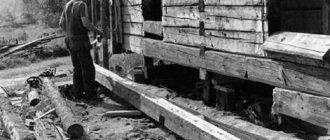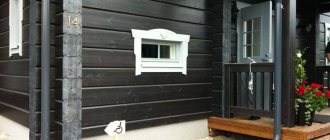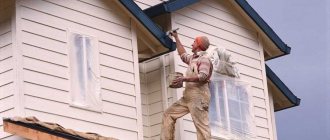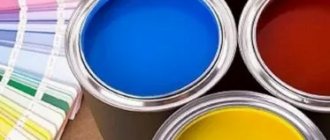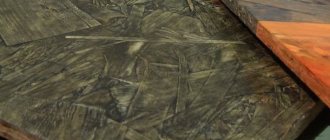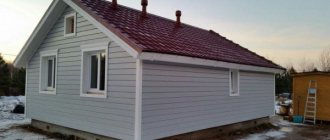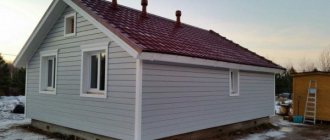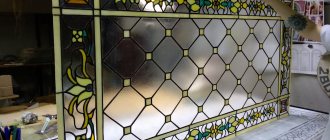A house built from timber attracts with its appearance. In addition, this structure has excellent technical characteristics. In order to keep the timber in good condition for many years, it is necessary to properly treat the walls outside and inside. You will learn how to treat the outside of a wooden house from the article. Today, there are various antiseptics that will cope with the task.
Choosing the right paint
Wood is a building material of natural origin and, unlike man-made brick and concrete, it reacts much more strongly to air humidity, wind, temperature fluctuations and solar radiation. Wood without bark can rot, burn out and become a haven for all kinds of molds and wood-boring beetles.
The factor that determines the service life and external decorative qualities of a log house is the choice of coating. Paints or impregnations for treating wooden façade walls are used to preserve wooden elements and must meet certain requirements:
- Create a surface protective layer that protects the wood from rain, snow and atmospheric moisture. Be frost-resistant (not destroyed by cyclical temperature changes).
- Have UV protection . Direct sunlight causes unprotected wood to change color (tanning effect) and lose its attractiveness.
- Have good adhesion (adhesion to the plane of the facade) and absorbency (important when processing with impregnation; penetration depth is indicated in the instructions for the product).
The type of paint is chosen based on its protective properties and visual appeal Source derevyannyy.com
- Demonstrate lack of moisture absorption .
- Be environmentally friendly . A parameter that is especially relevant for a log bathhouse.
- Don't lose your attractiveness. Varnish and acrylic compositions should not lose their original gloss. Paints must retain their original color .
- Contain fire retardant and antiseptic additives. Modern dyes are capable of maintaining the safety of a wooden structure.
- Be abrasion resistant .
The market offers a wide range of products suitable for painting the facade of timber and log houses. Modern coatings make it possible to preserve and emphasize the naturalness of the facade material or completely hide it under a protective layer. When deciding how to paint the exterior of a log house, owners give preference to proven, certified products. In practice, several types of coatings are used, the characteristics of which are useful to have an idea of.
The use of certified paints is a guarantee of high-quality painting Source fasad.guru
Antiseptic impregnations (waxes, stains) and varnishes
Liquid antiseptic impregnations for wooden surfaces penetrate the wood structure to a depth of 0.5-1 cm and create a barrier to all threats, natural and weather. There are two types of antiseptics on sale:
- Wax . Water-based wax is perfectly absorbed into wood, without creating a continuous film and maintaining its breathable properties. When finishing the exterior of a log house, a colorless or glazing (translucent) composition is used, creating a mother-of-pearl effect or an additional shade on the surface. Gives the facade water-repellent properties, leaving the natural structure visible.
- Wood stain . The composition is a tinting (impregnating) agent that colors the facade and protects it from biological contamination. The coating is short-lived, so a varnish is applied on top, which can extend the life of the stain and enhance its protective properties.
Treatment of wooden elements with fire retardant Source optimal-r.ru
- Varnishes (colorless or colored) are a proven, reliable means of protecting facades. Both options do not hide the natural texture of the wood; colored varnish can highlight its color. Varnishes, glazing impregnations and wax are used for painting not only outside, but also inside homes, where non-toxicity and external decorativeness are especially important.
Acrylic (acrylate) paints
Water-based acrylic paints for treating the external walls of a log house are considered the most acceptable, high-quality option with many advantages:
- contain solvents ;
- dry quickly and form a durable, vapor-permeable film;
- protect the wooden facade from ultraviolet radiation ;
- durable (resistant to weather vagaries);
- They retain their original color and shine for a long time (7-8 years) .
Impeccable appearance of acrylic paint Source materialyinfo.ru
See also: Catalog of companies that specialize in finishing materials.
The construction market offers several types of paints:
- Water-based acrylic paints . It is a water-acrylic emulsion (composition of two immiscible elements). After application to a wooden wall, the water evaporates, leaving a thin film layer with attractive properties on the surface. The paint does not have a strong odor, is flexible enough not to deteriorate under the influence of low temperatures, is vapor permeable (allows the wood to breathe) and at the same time waterproofs the facade.
- Water-based latex paints . They also contain acrylic resins, and therefore they are elastic, do not fade under solar ultraviolet radiation and are resistant to abrasion. Synthetic latex in the paint makes the surface silky in appearance. This paint is used when processing facades, window and door openings, and fences.
Types of decorative impregnation with water-based acrylates Source plantu.ru
- Alkyd compositions . They are produced on the basis of alkyd resins, which remain in the surface layer of wood to form a protective glossy layer. This paint fades quickly, but is resistant to negative temperatures and high humidity; it is often used to paint doors and window frames.
The disadvantage of acrylic dyes is their fairly high price. When painting log walls, they can be replaced with less expensive acrylate paints and aqualacs based on acrylate resins and dispersions, which reduce costs. These compositions have similar characteristics, they are safe and beautiful, but are designed for a shorter service life.
Oil based paint
Oil paint for a log house, used externally, is a familiar and fairly common method of painting. Despite its modest consumer qualities, it continues to be used; more often for painting fences than residential buildings.
Oil paint is a budget way to update a facade Source pkr.grunfest.ru
Protection with folk remedies
It is better to treat wood against rotting in dry weather with a low probability of precipitation. It is possible to work with antiseptic coatings even at sub-zero temperatures, but wood is saturated better and dries faster in the warm season, when temperatures reach 5-20 degrees. There should be no wind so that the wet surface is not covered with a layer of dust and dirt.
You should begin work by preparing the tool. In addition to antiseptic compounds, you will need:
- spray bottle (if the consistency of the solution is not viscous);
- roller, brushes;
- plane, sandpaper;
- rags;
- brush with stiff bristles;
- protective equipment (when using toxic coatings).
A more detailed list of necessary tools depends on the chosen method of wood processing.
Pros and cons of treating wood with waste oil
One of the common folk methods of protecting wood from rotting is treating the material with waste oil. Any engine oil that has served its intended period in a car or other equipment is suitable.
Among the advantages of this method:
- minimum costs;
- provides reliable protection against insects, rodents, mold and other microbiological processes;
- preventing early destruction of the wood structure;
- maintaining the density of the material.
When considering this option, one cannot ignore the negative nuances. The disadvantages of using used oil include:
- the technology is applicable only in non-residential buildings;
- the method is suitable for protecting small wooden elements;
- loss of color, damaged appearance of building material;
- oily surfaces are difficult to paint;
- not all types of oil are safe for wood; mineral-based oils have a mild effect;
- surfaces become easily flammable.
Taking into account the advantages and disadvantages of the method, the conclusion suggests itself: mining is an unsafe means of protecting wood, which can cause harm to human health and the structure of the material. It is better to give preference to antiseptic impregnations
Finnish wood processing method
There is a special way of treating wood from rotting and moisture - the Finnish method. It uses a set of available materials:
- flour;
- salt;
- slaked lime;
- inkstone;
- water.
All components must be combined in a spacious container until a homogeneous consistency is obtained. The thickness of the coating resembles sour cream. The finished mixture is placed on the fire and, with constant stirring, heated until warm. While the product has not cooled down, it is applied to wooden surfaces. Once the first layer is completely dry, begin applying the second ball.
This product stays on the boards for a long time and is not washed off with water. Despite its safe composition, the coating is used for material intended for arranging fences and roofing structures.
Liquid glass processing
One of the ways to protect wood from rotting involves applying liquid glass to the surface. The main condition of the technology is that the layer should not be less than 100 microns.
Sequence of work:
- Wear protective equipment (rubber gloves, cotton robe, glasses, closed shoes).
- Level the working surface of the wood, clean up chips.
- Dilute liquid glass with water in the ratio recommended by the manufacturer. It should have the consistency of jelly.
- Wood processing is carried out using a roller or brush. The operating temperature range is from -20 to +40 degrees, that is, in any weather without precipitation or strong wind.
- After the first layer has dried, the second is applied.
Despite all the advantages of liquid glass, it is not recommended to use this method of protecting wood in cases where surfaces are planned to be painted. After applying glass, the wood becomes smooth and a transparent film forms on the surface. The adhesion of wood deteriorates, but the material acquires water-repellent properties. Paint will not adhere to such a surface.
Stages of preparing a log house for painting
In order for the paint layer to lay smoothly and beautifully, and for the coating of wooden walls to satisfy the quality throughout the guaranteed service life, it is necessary to consistently prepare the facade, adhering to the technology. Before the exterior of a wooden house is processed, a number of preparatory works are carried out:
- Grinding . It is mandatory even for new buildings (from 1 to 3 passes are performed). The surface is sanded using a power tool (grinder with coarse abrasive). This treatment removes defects left after sawing (or manual processing) - chips and minor cracks. Sanding also opens the pores of the wood, which facilitates deeper penetration of impregnation and paint.
- Polishing . It is carried out with a grinder with a fine-grained nozzle or sandpaper (which significantly delays the process). As a result of processing, a fresh, lighter layer of wood appears; the surface becomes even and smooth, absorbs paint better.
Sanding prepares the surface for painting Source gdeprosto.ru
Is it necessary to prime the surface?
Wood protection consists of three main stages, after which you can begin to prime the surface.
A primer is necessary so that further finishing work can be carried out. In addition to the fact that the primer significantly increases adhesion between materials, it closes all pores from negative effects.
Priming is necessary to improve adhesion between layers of paints and varnishes
At the final stage, the outside of the timber is treated with a special bleaching agent. With its help, wood acquires a magnificent appearance. The final processing depends on what kind of finishing will follow. It is also possible to coat the wood with a special wax.
High-quality processing guarantees the preservation of the attractive appearance of a wooden house. But most importantly, the house will last much longer in this case. The environmental impact in this case will not be so destructive.
When performing all work, it is imperative to strictly follow all instructions from the manufacturers that are indicated on the packaging. It is also recommended to take the advice of experienced craftsmen who know all the intricacies of performing such work. And only in this case can you get a high-quality result for a long time, without the need to carry out repair work in the near future.
Painting the outside of a log house: stages of the process
Protective and decorative painting of a house made of rounded logs on the outside is the key to its long-term preservation without loss of visual appeal. Typically, processing is divided into several stages:
- Antiseptic . Impregnation of the facade with water- or oil-based antiseptics and fire retardants disinfects the wood and prevents new insects and microorganisms from appearing (1 to 2 passes are performed). It is convenient to apply the antiseptic through a spray bottle, so a respirator and safety glasses at this stage are not superfluous. Further procedures begin after the composition has completely dried.
- Primer . The purpose of the treatment is that the composition prepares the surface for final painting. The primer prevents tree resin from escaping (in knots) and staining the paint.
The paint color is chosen taking into account the style features Source gomabygg.com
- Adhesive primer (acrylic or oil, optional). The impregnating composition improves the adhesion of the base paint to the wooden wall and reduces paint consumption. Avoid getting dirt and dust on the drying primer.
- Cover paint . The main paint for a log house, the final layer that decorates and protects the walls. The ideal option is acrylic paint, applied in a thin layer sequentially in three steps, using a brush or roller.
Why are the ends sealed?
A special sealant is applied to the ends of the beam, which completely blocks the ingress of water through the end cut, without interfering with natural moisture and air exchange. Without sealant, moisture quickly absorbs and evaporates through the cross section, the wood swells, cracks, and collapses. It is easier for pests to penetrate the tree through the end. The most correct option is to tightly seal the ends.
Painting the outside of a log house: factors affecting quality
The quality of painting a wooden country house depends mainly on two factors:
- Weather . Ideal weather is dry and windless. Do not paint in the sun (the paint will dry too quickly and unevenly), during or after rain. The permissible temperature is determined by the type of paint (indicated on the label).
- Wood moisture content . It should not exceed 20% during painting, so façade walls made of wood with natural humidity are painted after the frame has shrunk.
A necessary condition for a quality result is ease of use Source projecty-domov.ru
Painting works and tools for them
Some have not encountered this type of work, so it will be useful for them to learn all the technical aspects of finishing with lining and painting it.
So, what tools will you need to carry out painting work:
- paint roller;
- paint brushes, the bristles of which should be hard. There should be several of them;
- construction tape;
- sandpaper (grit number 240);
- napkins;
- container for roller and brushes.
Painting tools
Treatment with protective compounds
The quality of your work will depend on attentiveness and accuracy, as well as on the correctness and consistency of compliance with all rules and recommendations. Full instructions are presented in the video:
Mistakes when painting a log house unqualified
If the desire to save on professional services for some reason outweighs the guarantee of the quality of the work performed, then after a while unsightly results such as stripes, stains and simply peeling areas on a recently painted surface are very likely. In such cases, the quality of the paint product is not always to blame. Unprofessional builders, due to inexperience, make basic mistakes that affect the final result:
- The facade is not properly prepared for painting: poor-quality sanding (or lack thereof) leaves the surface rough.
- painting technology (sequence) is violated
- Work is carried out in unsuitable conditions (high humidity or under the scorching sun).
- Newly erected ( naturally damp ) walls are painted.
- Incompatible materials were selected for painting .
Peeling of paint is caused by a violation of technology Source otdelka-expert.ru
How should wood be processed?
We process a wooden house
So, how to treat the lining inside and outside the house? To do this, you should adhere to a certain technology.
The wood processing process is similar for all substances, but working with antiseptics requires special care.
It is better to perform the work in the following sequence:
Decide which product you will use. Basically, substances are used that can protect wood from putrefactive changes and burning. The substance is applied with a brush or spray in 2 or 3 layers. It is worth starting the processing from the outside, and then proceeding to the internal work. If you don’t want to get your hands dirty, you can purchase wood that has already been properly processed at the factory, but additional protection will not be superfluous. Antiperen, which protects your canvas from burning, should be applied in two layers after the surface has been treated with antiseptic substances. Antiperen is able to penetrate deeply into the structure of the material, after which it is not afraid of even direct contact with fire. Today, on the shelves of hardware stores you can see various analogues of this substance, which are designed for specific purposes. But, it is necessary to take into account that the material may become charred, but direct combustion will not occur. Of course, not only wood can ignite from prolonged exposure to fire, but it is the fire retardant that makes it possible to extinguish the flame in time and prevent its distribution over the entire surface. The third layer with which the wood is treated is protection from moisture, because the house should not absorb water. For such purposes, impregnations with a water-repellent feature are most suitable.
Such a substance should evenly and thoroughly cover the entire wooden surface; special attention should be paid to the ends. It will be enough to treat the sides of the log with two layers of impregnation, but apply the substance in 4 or even 5 layers to the ends
This treatment will allow the wood to dry quickly, and the moisture will evaporate evenly, which will not lead to deformation of the wood.
If a wooden structure is properly treated inside and out, it will shrink evenly in the future, as a result of which you will be able to avoid the appearance of cracks, distortion and large gaps.
Painting an old wooden house
Over time, the painted facade begins to lose its attractive appearance - the paint peels off, mold appears, and the south side fades more rapidly. Sooner or later, the external walls of an old country house will require updating. Before repainting, the old coating is cleaned (for example, with a wire brush), and the surface is inspected to identify possible defects.
To ensure that the new layer goes on smoothly and lasts as long as it should, choose the same type of paint that was used originally. A study of the texture of the old coating will help determine what the façade was painted with:
- Acrylate paint . Thin, elastic structure reminiscent of leather; You can roll a piece of peeling paint into a roll.
- Oil paint . It has a matte color and may leave marks on your fingers after touching. You won’t be able to roll the roll—the fragment will crumble.
Old walls need careful preparation Source color-kostroma.ru
An old wooden house is painted in the same way as a new one. The difference is that it is not recommended to paint the old facade with a roller; it does not fill the unevenness that appears after periodic swelling and shrinkage of the fibers with paint. To give the old façade a neat look, painting the log house can be done in three or more layers.
Treatment of wood affected by bark beetle
The treatment process is as follows:
- Places where shashel larvae accumulate are determined (by sound or crumbling shavings). These areas are then marked with a marker.
- Using a long drill, holes are drilled into the wood with a depth of at least 1/3 of the thickness of the timber. Drilling is carried out at different angles to the surface.
- The affected surface is cleaned of dirt and dust with a metal brush. It leaves scratches on the wood, through which the antiseptic will seep deep into the wood, which increases the effectiveness of the treatment.
- The prepared surface is treated with a foam roller impregnated with an antiseptic composition. An antiseptic is injected into the holes made with a syringe.
It is advisable to carry out the treatment in the warm season and in a well-ventilated area. Usually, no later than an hour later, you can observe the process of migration of insects from the tree. If necessary, the treatment can be repeated.
Exterior painting of a log bathhouse
A bathhouse is a building with specific operating conditions; the interior of the log house is exposed to high humidity and temperature. Therefore, the main condition for the external coating is to maintain the vapor permeability of the walls. Otherwise, moisture will linger in the wood for a long time, creating a favorable environment for the development of mold microorganisms. When thinking about how to paint the exterior of a log bathhouse, do not forget about the nuances of processing the loghouse of a bathhouse:
- Logs must be dry and clean .
- In order for the protective layer of the new log house to serve as reliable protection, the lumber is treated with stain before collecting the crowns .
- Before repainting, the structure must be cool and ventilated .
Stages of processing and painting a bath Source do.59.ru
Impregnations are conveniently applied in the following sequence:
- Antiseptic . Products based on natural and synthetic oils are optimal.
- Fire retardant.
- Dye . The best option is acrylic facade paints, non-toxic, durable and vapor-permeable.
Processing results
- Long-lasting barrier against pests, insects, fungus. The sealant protects the end, the antiseptic impregnates the outer part, and the paint prevents the protection from being washed away.
- Ultraviolet light does not cause wood to darken. The house retains its “fresh” color. If the color is chosen correctly, then there is no resin release or burnout on the surface.
- Moisture protection. The film covers the entire wall, even after a serious rainfall the walls do not get wet.
- The house corresponds to the design project. The cottage is beautiful inside and out.
Brushing
This method of aging wood with your own hands is called from the concept brush, which translates as brush. The second name is tree structuring.
The degree to which it needs to age is determined by its purpose. If necessary, to create the appearance of deep antiquity, cutouts are made up to 3 mm. For floor coverings, such aging is not suitable, since it will collect a lot of dirt, and it is difficult to wash it off. On average, a depth of about 0.7 mm is left. Only hardwood can be aged using this method. Brushing wood improves its quality characteristics. It becomes stronger, lasts longer, and is not susceptible to attack by fungi and parasites.
Tools and materials for processing
The basis of the brushing aging method is cleaning with a hard metal brush. Soft fibers are cleaned manually. Using this tool, a relief is formed. The shorter the bristle of the brush, the more it will age after the procedure. Using a chisel, apply straight deep stripes, changing their curvature. Sandpaper is used to emphasize the resulting effect.
After the first stage is completed, the wood is coated with paint that has its own natural wood shades. The coloring composition is applied unevenly on purpose. This is how the upper layers age, they acquire a dark shade, while the lower ones remain lighter. The relief after this coloring stands out even more. The ideal texture of aging wood is created by gray-white paint. Before it completely dries, the top layer is wiped off the surface. The result is the appearance of a tree that is at least 10 years old.
Processing technology
Before aging by structuring, the wood must be prepared. Lumber is selected without defects with a moisture content of 10-15%. Otherwise, the fibers will not be processed and will break. How to properly age wood with your own hands:
- Moisten the surface so that there is not a lot of dust during work.
- The brush should move in the direction of the grain. Remove only soft wood fibers.
- The speed should be moderate so that the wood does not heat up.
- Primary grinding is done with a polymer brush with abrasive. Remove torn fiber residues using sandpaper. After removing the roughness, it will become clear how well the aging was done.
- If necessary, make the grooves better by brushing again.
- Decoration is done with a chisel. The appearance of cracks is created.
- Polishing. It is carried out with a sisal or hair brush, if aging is carried out with a grinder or a grinder. The final appearance of the workpiece is given. For the same purposes, fine-grain sandpaper is used for manual processing.
- Next, the piece of lumber needs to be dried and then completely cleaned of dust.
- A layer of stain creates a contrasting pattern. A generous layer without rubbing and quickly removing excess will dye soft fibers and leave hard fibers light. Gold and silver colors look especially advantageous if the wood is aged.
- Patination is the darkening of deep furrows. Gives nobility when aging.
- Finally, polish again, erasing any unevenness after painting.
- Varnishing is done with parquet varnish.
If you age the workpiece in this way, it will preserve the characteristics of the breed for a long time.
Plastering rules
When increasing the use and aesthetics of wooden buildings with the help of plaster, special rules are observed. There is a difference between finishing log houses and frame houses. The influence of temperature and humidity parameters on the expansion and contraction of wood is taken into account.
Only the wooden surfaces of the frame structures are plastered without delay. Such walls do not carry a load, but serve only as thermal insulation, and therefore are not subject to shrinkage. The house is finished with plaster both inside and outside.
New or repaired log houses are left under the roof for 1-3 years to shrink. During this period, natural shrinkage of the wood occurs, as well as mechanical shrinkage: compression of logs under the influence of weight, compaction of inter-crown insulation. The period of maintenance of a building also depends on the direct influence of atmospheric influences on the frame, the type of wood, and the processing method.
Mesh for plastering wooden walls
Work is carried out at a temperature of +10о – +20оС. Negative atmospheric influences (heat and frost) affect the binding of the solution to the wood. The coating cracks and peels off.
How to get rid of wood blue stains
An alarming “bell” is a change in the color of the wood and the appearance of bluish or blue-gray bald spots on the surface of the external walls; a log house under shrinkage is most often susceptible to this phenomenon. The appearance of blue discoloration is caused by the development of a fungus that feeds on wood starch and glucose. Blue appears actively in the first months after the construction of a log house; the cause of this phenomenon is most often the use of waterlogged timber.
It is believed that blue fungus does not destroy wood fibers, the tree retains its properties, but its appearance indicates that something is wrong with the wood material and measures must be taken. In recent studies, scientists have noted that blue damage does not go away without a trace; in the affected areas, an increase in pores is observed and hygroscopicity increases. This phenomenon reduces the service life of the structure.
The blue develops from the outside and penetrates deeply into the timber; sanding does not completely eliminate this defect; the façade of a house with blue-gray stains has an unpresentable appearance. Blue mold is easily eliminated with chlorine bleaches “Belizna”, “Iney”, “Sagus”. It is advisable to carry out the treatment immediately after the first signs of damage appear; if the timber is covered with blue in the stack, it is advisable to treat it before laying it in the log house and further dry it in a well-ventilated place.
Wood blue: 1-surface; 2-deep.
No. 6. Wall panels
Thanks to the use of wall panels, walls can be transformed beyond recognition and completely any design idea can be realized; with their help, only certain areas are often decorated: above the bed, kitchen apron, near the bathroom. Wall panels are made from different materials:
- wood and bamboo;
- veneered and laminated MDF;
- glass (transparent, frosted, printed);
- leather;
- plastic.
Panels can be type-setting or panel-type. Stacked ones have a large length and a small width, and are connected according to the tongue-and-groove principle. Wooden lining, in fact, belongs to panel wall panels, but its wide distribution and unique properties have made it possible to distinguish it into a separate class of finishing materials. Panel panels already have a more comparable length and width.
Wall panels are attached to the lathing, the pitch of which depends on the parameters of the finishing material. The variety of designs cannot be described in words, but not all such panels meet the requirement of environmental friendliness: leather and glass will not disturb the microclimate, which cannot be said about plastic panels. However, even plastic panels, incl. and plastic lining have the right to be used for finishing a bathroom, toilet or kitchen.
